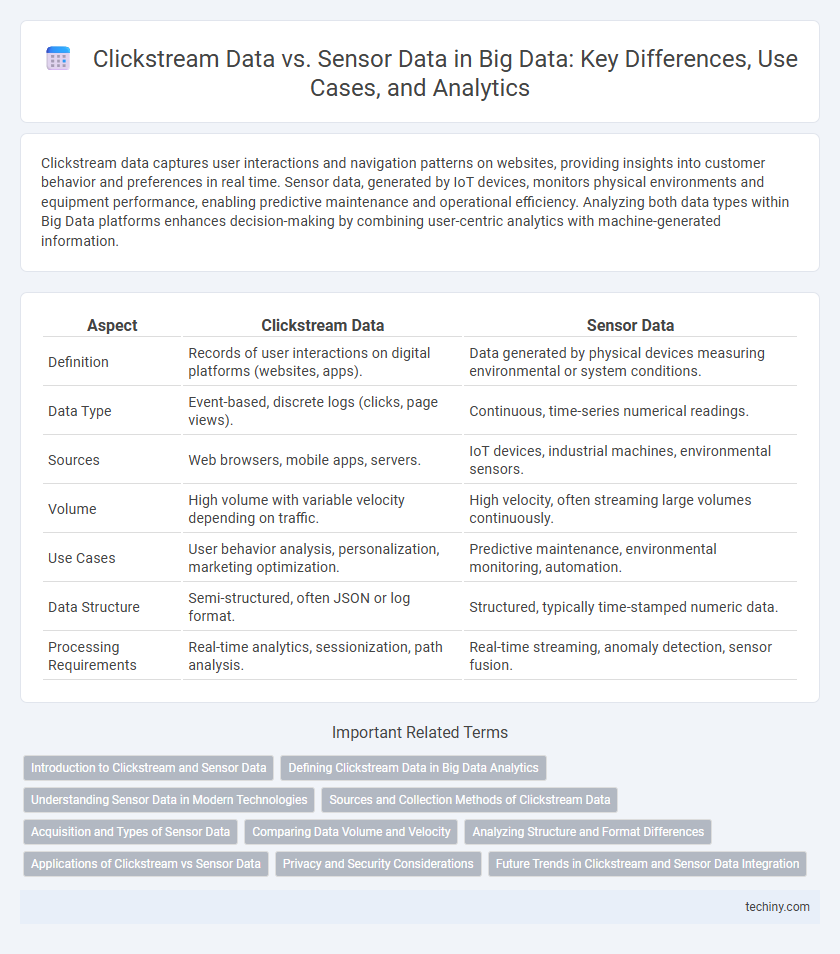Clickstream data captures user interactions and navigation patterns on websites, providing insights into customer behavior and preferences in real time. Sensor data, generated by IoT devices, monitors physical environments and equipment performance, enabling predictive maintenance and operational efficiency. Analyzing both data types within Big Data platforms enhances decision-making by combining user-centric analytics with machine-generated information.
Table of Comparison
| Aspect | Clickstream Data | Sensor Data |
|---|---|---|
| Definition | Records of user interactions on digital platforms (websites, apps). | Data generated by physical devices measuring environmental or system conditions. |
| Data Type | Event-based, discrete logs (clicks, page views). | Continuous, time-series numerical readings. |
| Sources | Web browsers, mobile apps, servers. | IoT devices, industrial machines, environmental sensors. |
| Volume | High volume with variable velocity depending on traffic. | High velocity, often streaming large volumes continuously. |
| Use Cases | User behavior analysis, personalization, marketing optimization. | Predictive maintenance, environmental monitoring, automation. |
| Data Structure | Semi-structured, often JSON or log format. | Structured, typically time-stamped numeric data. |
| Processing Requirements | Real-time analytics, sessionization, path analysis. | Real-time streaming, anomaly detection, sensor fusion. |
Introduction to Clickstream and Sensor Data
Clickstream data captures user interactions and navigation paths on websites or applications, providing detailed logs such as page views, clicks, and time spent on each element, which are essential for behavioral analytics and personalization. Sensor data originates from IoT devices and embedded sensors, recording real-time environmental or operational parameters like temperature, pressure, and motion, enabling predictive maintenance and smart automation. Both data types generate massive volumes requiring advanced big data processing frameworks for collection, storage, and analysis.
Defining Clickstream Data in Big Data Analytics
Clickstream data in big data analytics refers to the digital trail users leave by clicking on websites, capturing detailed information such as page views, timestamps, and user interactions. This data provides critical insights into user behavior, enabling businesses to optimize web experiences and personalize marketing strategies. Unlike sensor data, which originates from physical devices monitoring environmental or mechanical conditions, clickstream data specifically reflects online user activity within digital platforms.
Understanding Sensor Data in Modern Technologies
Sensor data in modern technologies captures real-time information from physical environments, providing critical insights for Internet of Things (IoT) applications, smart cities, and autonomous vehicles. Unlike clickstream data that records user interactions on digital platforms, sensor data encompasses diverse formats such as temperature readings, motion signals, and biometric inputs, enabling advanced analytics for predictive maintenance and environmental monitoring. Processing sensor data involves handling high-velocity, high-volume streams requiring robust edge computing and cloud infrastructures for efficient storage and real-time decision-making.
Sources and Collection Methods of Clickstream Data
Clickstream data originates from user interactions on websites and digital platforms, collected through tracking technologies such as cookies, web beacons, and server logs. This data captures detailed user behavior including page views, clicks, and navigation paths, enabling granular analysis of online activity. Collection methods rely on integrating tracking scripts within web pages and mobile apps to record real-time user actions seamlessly.
Acquisition and Types of Sensor Data
Clickstream data is acquired through user interactions on websites, recording clicks, page views, and session durations to analyze online behavior. Sensor data, collected via IoT devices and embedded sensors, includes types such as temperature, motion, humidity, and biometric readings, enabling real-time environmental monitoring and predictive analytics. Acquisition of sensor data involves continuous streaming from physical sources, requiring robust handling for high-volume, time-series data integration in big data systems.
Comparing Data Volume and Velocity
Clickstream data typically generates massive volumes due to continuous user interactions on websites, with high velocity as events occur in real time and require immediate processing for analytics. Sensor data, while also voluminous, often presents even higher velocity as sensors stream constant updates from IoT devices and industrial equipment, demanding rapid ingestion and low-latency analysis. The distinct difference lies in clickstream data's event-driven bursts versus sensor data's steady, high-frequency data flow, impacting storage architecture and real-time processing frameworks in big data environments.
Analyzing Structure and Format Differences
Clickstream data consists of sequential, timestamped user interactions captured as log files or JSON objects, reflecting web navigation behaviors through structured event records. Sensor data typically arrives as continuous, time-series streams with high-frequency readings stored in formats like CSV or specialized binary protocols, demanding real-time processing of numerical or categorical measurements. The key difference lies in clickstream's discrete, event-driven format versus sensor data's continuous, often heterogeneous streams, influencing storage, processing frameworks, and analytical techniques.
Applications of Clickstream vs Sensor Data
Clickstream data is primarily used in digital marketing, user behavior analysis, and e-commerce optimization by tracking online user interactions such as clicks, page views, and navigation paths. Sensor data finds extensive applications in industries like manufacturing, healthcare, and smart cities, enabling real-time monitoring, predictive maintenance, and environmental sensing. Both data types enhance decision-making, with clickstream data driving personalized digital experiences and sensor data supporting operational efficiency and safety improvements.
Privacy and Security Considerations
Clickstream data collection captures detailed user interactions on websites, raising concerns about user consent, data anonymization, and potential exposure of personal browsing habits. Sensor data, often gathered from IoT devices, involves continuous monitoring in physical environments, posing risks related to unauthorized access, data breaches, and real-time tracking vulnerabilities. Effective encryption, strict access controls, and compliance with regulations like GDPR are critical for safeguarding both clickstream and sensor data privacy and security.
Future Trends in Clickstream and Sensor Data Integration
Future trends in clickstream and sensor data integration highlight the increasing use of advanced machine learning algorithms to enhance real-time analytics and predictive insights. The convergence of IoT sensor outputs with user behavioral clickstream data enables more personalized customer experiences and smarter decision-making across industries such as retail, healthcare, and manufacturing. Emerging platforms focus on scalable architectures that support the seamless fusion of heterogeneous data streams for improved accuracy and operational efficiency in big data ecosystems.
Clickstream Data vs Sensor Data Infographic

 techiny.com
techiny.com